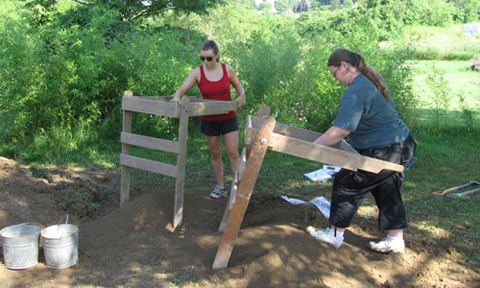
Archaeology Field Camp students work at the Patton habitation site, with Patton Bog in the background.
Picture Athens County today. Dense forests and rolling hills.
But it hasn’t always looked like this.
Climate change and human activity have combined, research suggests, to alter the hills of Southeastern Ohio many times over the past 3,000 years.
Prairie grassland? Ragweed gardens? Park-like woods without dense undergrowth? Clear-cut forests? These are all part of the likely history of Athens County, new research suggests.
How do we know what the climate was like long ago without meteorological records? And how do we discover which changes were caused by climate and which were more likely human activity?
Archaeologists tend to dig up their answers. For Dr. Elliot Abrams’ and Dr. AnnCorinne Freter’s recent project, they didn’t dig up arrowheads or pottery shards. Cores of sediment from an Athens County bog served as their window to the past. And tiny pollen grains provided climate clues.
Abrams and Freter, both Professors of Anthropology at Ohio University, published “Environmental Change Since the Woodland Period in the Mid-Ohio Valley: Results from Patton Bog Sediment Core Palynological Analyses” in the May 2014 issue of the Midcontinental Journal of Archaeology. Their co-author is Vania Stefanova of the University of Minnesota.
Climate Change and Man’s Changing Behavior
Climate changes such as warming, cooling and drought, write Abrams and Freter, coupled with human activity, led to “environmental changes (that) influenced human decisions concerning plant domestication and diet in the mid-Ohio Valley” from 3000 B.C. to the present.
By taking sediment cores in Patton Bog, Abrams and Freter analyzed the first historical pollen data from this region. “The record from Patton Bog is unique for southeastern Ohio and contributes to our understanding of plant domestication, diet and human land use and decision-making for the critical Woodland Period beginning circa 1000 B.C.”
Patton Bog is adjacent to a Native American habitation site occupied from around 1000 B.C. to A.D. 100, making it a good place to look for evidence of early gardening or farming, as well as how the inhabitants responded through the Medieval Warm Period and the Little Ice Age that caused climate change in North America.
“It has long been recognized in anthropological archaeology that environmental changes have had a significant impact on human land use decisions in a wide range of ecological settings,” they write. In the Ohio Valley and surrounding regions, “environmental changes led to substantial, often abrupt, rearrangements of terrestrial ecosystems,” but the relationships between people and climate “are regionally and culturally specific and often unclear.“
Pollen Grains Buried in the Bog
In search of answers, the team took three core samples from the southern end of Patton Bog in 2008.
One sample remains untouched, but the other two have been “cooked” and “accelerated.”
At the National Lacustrine Core Repository at the University of Minnesota, the samples were heated to 105 degrees Celsius—akin to a warm oven—to determine dry density. But the next steps went way beyond broil—up to 1000 C, or about 1832 F. This “loss on ignition” analysis determined organic matter and carbonate content (a rainfall indicator).
Three small samples of a core took a ride out to the Lawrence Livermore National Laboratory in California, where the Center for Accelerator Mass Spectrometry attempted radiocarbon dating.
The charcoal sample was too old. The Carex seed sample was too small. But the wood sample was just right. With a date range of 1089-890 B.C., it helped the researchers to align their core samples with other datasets and build a timeline.
Among the key evidence that would help them decipher what the sediment layers had to say about life at Patton Bog were charcoal and pollen grains. More than 300 pollen grains were identified in the samples. Read more about “Life at Patton Bog.”
Interpreting the Data
In the Early Woodland Period (circa 1000 B.C. to A.D. 1), the pollen data suggests a prairie or grassland environment around Patton Bog. Piecing together their data with other regional evidence, the researchers suggest that declining rainfall and warmer summers may have been more conducive to grasslands than forests.
In the Middle Woodland Period (A.D. 1 to 400), the landscape around Patton Bog continued to be dominated by prairie, but charcoal began to appear. Increased warming, with high summer temperatures, is indicated by various data sources.
“Non-random burning is viewed as anthropogenic (human-induced) in origin, and these fires relate to an intensification of a gardening or swidden agriculture system or a desire to simply maintain a grassland environment free from tree encroachment.”
In the Late Woodland/Late Prehistoric Period (A.D. 400-1450), maize pollen appears in the sample, as well as an increase in carbonate content, which indicates an increase in rainfall.
“More importantly, a doubling in charcoal from this timespan relative to the Middle Woodland period reflects significantly increased use of fire to maintain the open landscape and perhaps to facilitate hunting and travel.”
In the Historic Period (A.D. 1800 to the present), Euro-American settlements arrived in southeastern Ohio. “Written accounts describe the forests as open and park-like and report the use of fire by Native Americans as a land-management tool,” they write. “The high charcoal amount in the sediments…confirm that the early European settlers continued to use fire until the early 1900s.”
The settlers also clear-cut the forests and mined coal to feed the iron industry, as evidenced by decreasing oak pollen in the samples.
“With the introduction in fire suppression policies in 1923, the fire-maintained open landscape was converted to closed-canopy forests that cover about 77 percent of Athens County today,” they write.
Read more about “Life at Patton Bog.”
This research was funded through an Ohio University Baker Grant awarded to Abrams, and Abrams and Freter thank David and Marlene Patton for granting permission to conduct the wetland research on their property.

















Comments